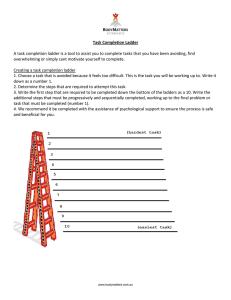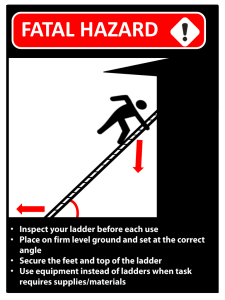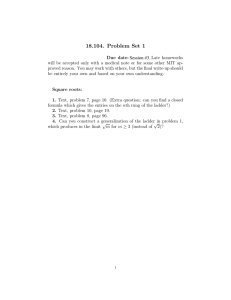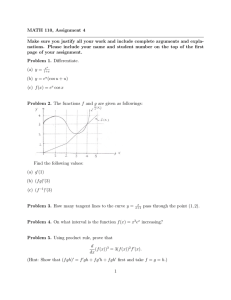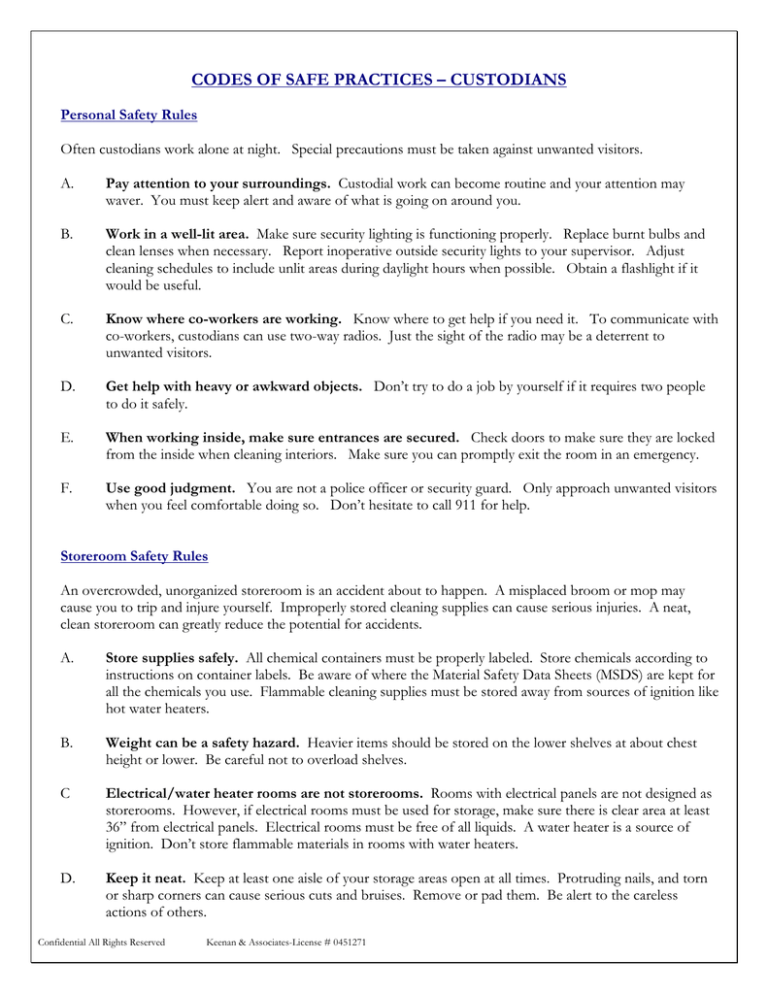
CODES OF SAFE PRACTICES – CUSTODIANS
Personal Safety Rules
Often custodians work alone at night. Special precautions must be taken against unwanted visitors.
A.
Pay attention to your surroundings. Custodial work can become routine and your attention may
waver. You must keep alert and aware of what is going on around you.
B.
Work in a well-lit area. Make sure security lighting is functioning properly. Replace burnt bulbs and
clean lenses when necessary. Report inoperative outside security lights to your supervisor. Adjust
cleaning schedules to include unlit areas during daylight hours when possible. Obtain a flashlight if it
would be useful.
C.
Know where co-workers are working. Know where to get help if you need it. To communicate with
co-workers, custodians can use two-way radios. Just the sight of the radio may be a deterrent to
unwanted visitors.
D.
Get help with heavy or awkward objects. Don’t try to do a job by yourself if it requires two people
to do it safely.
E.
When working inside, make sure entrances are secured. Check doors to make sure they are locked
from the inside when cleaning interiors. Make sure you can promptly exit the room in an emergency.
F.
Use good judgment. You are not a police officer or security guard. Only approach unwanted visitors
when you feel comfortable doing so. Don’t hesitate to call 911 for help.
Storeroom Safety Rules
An overcrowded, unorganized storeroom is an accident about to happen. A misplaced broom or mop may
cause you to trip and injure yourself. Improperly stored cleaning supplies can cause serious injuries. A neat,
clean storeroom can greatly reduce the potential for accidents.
A.
Store supplies safely. All chemical containers must be properly labeled. Store chemicals according to
instructions on container labels. Be aware of where the Material Safety Data Sheets (MSDS) are kept for
all the chemicals you use. Flammable cleaning supplies must be stored away from sources of ignition like
hot water heaters.
B.
Weight can be a safety hazard. Heavier items should be stored on the lower shelves at about chest
height or lower. Be careful not to overload shelves.
C
Electrical/water heater rooms are not storerooms. Rooms with electrical panels are not designed as
storerooms. However, if electrical rooms must be used for storage, make sure there is clear area at least
36” from electrical panels. Electrical rooms must be free of all liquids. A water heater is a source of
ignition. Don’t store flammable materials in rooms with water heaters.
D.
Keep it neat. Keep at least one aisle of your storage areas open at all times. Protruding nails, and torn
or sharp corners can cause serious cuts and bruises. Remove or pad them. Be alert to the careless
actions of others.
Confidential All Rights Reserved
Keenan & Associates-License # 0451271
Ladder Safety Rules
A.
Use a straight ladder if you must lean the ladder against a support. Avoid using an “A” frame
ladder in this situation – it’s not the right equipment for the job. Metal ladders must not be used near
exposed electrical circuits or power lines. “A” frame ladders are safest if they are ten feet or less in
length – never use one over 20 feet long.
B.
Inspect the ladder before you use it. No ladder is safe if it is missing rungs, if the rungs or rails are
defective, or if it is in a weakened condition. Wood ladders should be inspected for side rails that are
cracked or split, and sharp edges or splinters on cleats, rungs or side rails. Make certain spreaders can be
locked in place. Be sure straight ladders have safety feet. If a ladder cannot be repaired, dispose of it
promptly.
C.
Set up your ladder safely. If you must set up a ladder in a traffic area, use a barricade or guard to
prevent unexpected collisions. Lock or block any nearby doors that open toward you. Keep the area
around the ladder base uncluttered. Avoid side-to-side tilting by resting your ladder base on a solid, level
surface. When using a stepladder, make sure it’s fully open and its spreader is locked. Position a straight
ladder at a four-to-one ratio – means every four feet of the ladder’s length to one foot away from the
support point. Never lean a ladder against an unstable surface.
D.
Climb and descend ladders cautiously. Face the ladder and hold on with both hands. If you need
tools, carry them in a tool belt or raise and lower them with a hand line. Don’t take a chance on slipping
– check ladder rungs and the bottoms of your shoes for slippery substances. Take one step at a time and
don’t skip steps.
E.
Use common sense when working on ladders. Never reach or lean too far to either side. To
maintain your balance, keep your belt buckle between the ladder rails. Don’t climb higher than the
second tread from the top on a stepladder or the third rung from the top on a straight ladder. Only one
person may be on a ladder at a time. Don’t place tools on the rungs or top of the ladder.
Electrical Powered Tool Safety Rules
Tools can save time and make your job easier, but each power tool has potential risks that must not be ignored.
Because you use your tools daily, you can begin to take them for granted. Always think “safety” when using your
tools.
A.
Manufacturers supply manuals with tools and equipment. Read the manuals before you use the
equipment. Keep the manuals handy for future reference. Have an experienced operator provide
instructions and a demonstration of the equipment before you use it. Practice using the equipment
before you begin a large-scale job.
B.
Prepare the equipment and yourself for work. Examine the tools for safety defects before you use
them. Check electrical cords for frayed wires and defective plugs. If an extension cord is required, make
sure the gauge of wire in the cord is compatible with the power supply and tool. Make sure the ground
plug is in place. Examine the tool for cracks and safety defects. Check for loose or missing bolts and
knobs. Keep safety guards in place at all times. Wear protective clothing provided by your supervisor
and recommended by the equipment manufacturer (See Protective Clothing Reference Chart).
Confidential All Rights Reserved
Keenan & Associates-License # 0451271
C.
Avoid hazards while operating equipment. Clear the work area of trip, slip, and fall hazards and
things that might get in your way while working. Designate the work areas with safety cones when
possible. Keep a tight grip on the equipment, and position the tool comfortably close to your body.
Be mindful of others around you. Always shut off the tool when you are not using it and disconnect it
from the power supply
D.
Charging batteries can be dangerous. Take special precautions when charging batteries on electric
carts. Read the manual before beginning. Charge the batteries only in a well-ventilated area away from
any sources of ignition and where there is an eye wash station and deluge shower.
E.
Report any inoperative or unsafe equipment to your supervisor. Take unsafe equipment out of
service until it can be repaired or replaced.
Fuel Powered Tool Safety Rules
These tools have potential risks that must not be ignored. Oscillating blades on hedge trimmers can cut and
maim. High velocity air from blowers can kick up dust and debris into the eyes and lungs. The cutting surfaces
of chain saws are capable of gnawing chunks of skin and bone. Tools can save time and make your job easier,
but each power tool has potential risks that must not be ignored. Because you use your tools daily, you can
begin to take them for granted. Always think “safety” when using your tools.
A.
Manufacturers supply manuals with tools and equipment. Read the manuals before you use the
equipment. Keep the manuals handy for future reference. Have an experienced operator provide
instructions and a demonstration of the equipment before you use it. Practice using the equipment
before you begin a large-scale job.
B.
Take care when refueling and storing the equipment. Using a safety can, refuel on a hard surface in
a well ventilated area. Refuel when the tool or equipment is cool and let the piece cool before
transporting and storing it. If storing for long periods, drain the liquids. Fuel must be kept in and
dispensed from an Underwriters Laboratory (UL) listed safety container and stored in a properly vented
flammable liquids cabinet.
C.
Prepare the tool and yourself for work. Examine the equipment for safety defects before you use
them. Examine the tool for cracks and safety defects. Check for loose or missing bolts and knobs.
Keep safety guards in place at all times. Wear protective clothing provided by your supervisor and
recommended by the equipment manufacturer (See Protective Clothing Reference Chart).
D.
Avoid hazards while operating equipment. Clear the work area of trip, slip, and fall hazards and
things that might get in your way while working. Designate the work areas with safety cones when
possible. Be mindful of pedestrians, wire fences and objects hidden in the grass and hedges. Shut off
the tool when not using it. Remember, hot tools can cause severe burns.
Lifting Rules
It is just as important to keep your body in shape for the task as it is any other tool you use for other jobs. You
can injure yourself just as easily lifting light objects as you can lifting heavier ones if you don’t lift properly and
your “tool” is not in shape for the job. Lifting is a thinking person’s job.
Confidential All Rights Reserved
Keenan & Associates-License # 0451271
A.
Before you lift something, prepare yourself and plan the move. Make sure you are limber and
physically fit enough to do the task safely. Daily exercises will keep your body ready for lifting and help
you feel better. Size up the load to make sure you can handle it safely. If you think the load is too bulky
or too heavy, ask someone to help you or try to break it up into smaller, more manageable loads. Use a
hand truck or dolly if necessary. Plan your route and make sure the path is clear of trip, slip, and fall
hazards.
B.
Use proper body mechanics when lifting. Stand close to the object with your feet about shoulder
width apart. Squat down, bending at the hips and knees. Keep your back straight. As you grip the load,
arch your lower back inward by pulling your shoulders back and sticking your chest out with chin tucked
in. Be sure to keep the load close to your body. When you set the load down, squat down, bending at
the hips and knees, keeping your lower back arched in.
C.
Turn, don’t twist. Twisting is not the thing to do. Instead of twisting, turn your whole body in the
direction that you want to go. Twisting when carrying a load puts a lot of undo stress on your back.
D.
Push, don’t pull. Whenever you have to move something that’s on a cart, a dolly, or a hand truck, push
the load. Pushing puts less strain on your back.
E.
Don’t store heavy objects higher than your waist. If heavy objects aren’t stored higher than your
waist than you won’t have to lift them higher than your waist. Lifting objects overhead puts a lot of
undue stress on your back. It’s one of the surest ways to injure your back.
F.
Lift like a pro and avoid the pain. Learning how to lift and carry safely is one of the most important
things you can do for your back. It’s not hard to put these suggestions to use, and the payoffs will be
well worth the time and effort you put into it.
Riding Equipment Safety Rules
Not only the operator of riding equipment is at risk, but also other staff and students in the area. Awareness of
safety must be high at all times when using this equipment.
A.
All riding equipment comes equipped with manuals. Read the manuals and become completely
familiar with the equipment before using it. Keep the manuals handy for future reference. Have an
experienced operator provide instructions and a demonstration of the equipment before you use it.
Practice on a small area before taking the equipment out on the job.
B.
Prepare the equipment and yourself for work. Thoroughly inspect the equipment prior to using it
(most equipment manuals have inspection checklists). Make sure all the factory installed safety devices
are operating properly, and don’t use the equipment if they are not. Immediately report all equipment
faults to your supervisor. Wear protective clothing. (See Protective Clothing Reference Chart).
C.
Avoid hazards while operating the equipment. Before you start to use the equipment clear the work
area of potential hazards. Check the area for rocks and small objects that could be hurled by the blades.
Remove other obstructions. Designate the work areas with safety cones or barrier tape when possible.
Confidential All Rights Reserved
Keenan & Associates-License # 0451271
D.
Keep alert. While using some riding equipment, it is possible to lose concentration. You must guard
against becoming unaware of your surroundings. Keep staff and students at a safe distance from the
equipment and work area. Never allow other riders on the equipment when you are operating it.
Students are never allowed on any riding equipment.
E.
Do not leave the equipment unattended. After turning off the equipment according to the manual
instructions, remove the ignition key. The equipment must never be left unattended in an area where
students have access – children may think it is an interesting toy, not the potentially dangerous piece of
equipment it is.
F.
Follow shutdown instructions in the manual. Carefully follow the post-operating instructions
contained in the manual. Always clean the equipment after use and store it in a secure area.
Confidential All Rights Reserved
Keenan & Associates-License # 0451271
PROTECTIVE CLOTHING REFERENCE CHART
Note: This is a general reference chart only. Always consult the tool/equipment manual or your supervisor for
the required protective clothing before using any tool or equipment.
TOOL/EQUIPMENT
Goggles
Gloves
Hearing
LINE TRIMMER
X
X
X
EDGER
X
X
X
HEDGE TRIMMER
X
X
X
X
X
X
X
X
X
PRESSURE WASHER
X
X
POWER AUGER
X
X
TRENCHER
X
X
LITTER VACUUM
X
X
ROTOTILLER
X
X
CHAIN SAW
Hard Hat
X
BLOWER
PAINT STRIPER
X
X
X
MOWERS (WALK BEHIND)
X
X
X
X
X
EQUIPMENT (RIDING)
Mask
X
X
PESTICIDE/HERBICIDES
X
X
ELECTRIC POWER TOOLS
X
X
X
X
AR
AR
AR
AR
AR= As recommended in
manual
OTHER
TOOLS/EQUIPMENT
Confidential All Rights Reserved
AR
Keenan & Associates-License # 0451271
X

